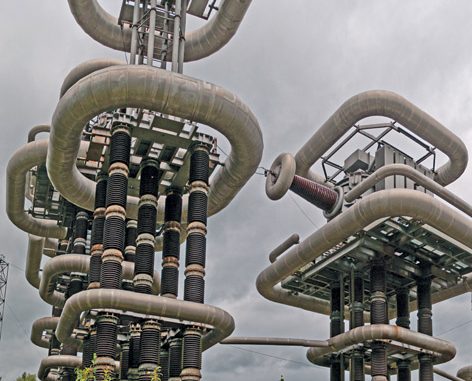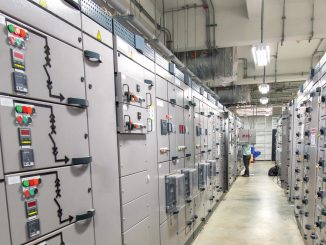
HV and EHV applications
In order to connect new generation sources to load centres as well as meet the need for reliable power supply, it is crucial that proper power evacuation infrastructure is in place. The voltage of transmission lines depends on the quantum of power and the distance involved in the transmission of that power. In India, the transmission network includes extra high voltage (EHV) at 66kV, 110 kV, 220/230 kV, 400 kV and 765 kV alternating current (AC) levels, and ±500 kV and ±800 kV at high voltage direct current (HVDC) levels. Further, there has been a growing focus on the development of ultra high voltage (UHV) transmission network whichcomprises voltages of 1,000 kV (AC) or above. It allows long distance transmission of power while minimising network loss, controlling voltage fluctuations and minimising the right-of-way requirement.
Switchgear is a critical component of the equipment supply chain in the transmission segment. Air-insulated switchgear and gas-insulated switchgear (GIS) are the most widely deployed switchgear technologies in India and worldwide. However, there are several modern technologies available now including hybrid switchgear, green switchgear and intelligent switchgear that are more compact, environment friendly and “smart”. So far, growth in the switchgear industry has been driven by a strong demand for low voltage (LV) and medium voltage (MV) switchgear from distribution and sub-transmission networks. However, in the last year, the growth in demand for high voltage (HV) switchgear was greater than that for LV and MV switchgear. In 2017-18 (up to January), HV switchgear recorded a growth of 15.7 per cent while that of MV and LV switchgear was 3 per cent and 4.5 per cent respectively. In the coming years too, the demand for HV and UHV switchgear is expected to drive the growth of the switchgear industry.
EHV network in India
The transmission network at voltage levels of 220 kV and above aggregates to around 377,520 ckt. km and 812,378 MVA of transformer capacity. In addition, there is about 6,124 ckt. km and 9,000 MW of transformer capacity at the ±800 kV HVDC level. The first ±800 kV HVDC line in the country, the Biswanath Chariali-Agra bipole line, was commissioned in September 2015 by Power Grid Corporation of India Limited (Powergrid). Apart from the ±800 kV HVDC network, there exists about 9,432 ckt. km of lines and 13,500 MW of transformer capacity at the 500 kV level. However, no network addition has been made at this level in the past five years.
In 2017-18, over 19,500 ckt. km of HV transmission lines and 73,300 MVA of transformer capacity was added. The key lines commissioned include the 765 kV line connecting the Jabalpur pooling station in Madhya Pradesh with the Orai substation in Uttar Pradesh, and the 400 kV Aurangabad-Boisar line. Amongst the key substations commissioned were the 1,500 MVA Alipurduar and Agra substations, and the Champa and Kurukshetra HVDC substations.
A significant development in the UHV transmission segment has been the commissioning of Powergrid’s 1,200 kV UHVAC National Test Station (along with 1,200 kV single and DC transmission line sections, and associated 1,200 kV bays) at Bina in Madhya Pradesh, which is the world’s first hybrid GIS to be energised at this voltage level.
As per the National Electricity Plan, 2018, around 107,500 ckt. km of transmission lines, 333,479 MVA of transformer capacity, and 14,000 MW of HVDC capacity is expected to be added by 2022. Amongst the key projects under implementation are the ±800 kV Raigarh-Pugalur HVDC bipole link and the North Eastern Region Power System Improvement Project (NERPSIP). The 3,676 ckt. km Raigarh-Pugalur two-way link will be the country’s first green energy corridor project and entails an estimated cost of Rs 147 billion. The NERPSIP project is being implemented by Powergrid in Assam, Meghalaya, Manipur, Mizoram, Nagaland and Tripura. It envisages the construction of 34 new EHV substations along with 2,114 ckt. km of EHV transmission lines.
Conclusion
The transmission voltage landscape has been shifting towards higher voltages as it enables the flow of more power and integration of renewable energy. This is also evident from the current 25 per cent share of the 765 kV voltage level in Powergrid’s transmission lines as against only 2 per cent in 2012. The upcoming trend in the transmission segment is that of the UHV network. The power transfer capacity of a UHV line is around 4.2 times higher than that of a 765 kV line. However, there are a number challenges that remain to be addressed, such as high cost (about 3.5 times more than a 765 kV line), lack of testing facilities for UHV equipment, shortage of skilled manpower, lack of standardisation in technical specifications and delays in the bidding process. That said, overall, the demand for switchgear is expected to go up with the expansion in the transmission network, most of which will be for high voltage equipment.



